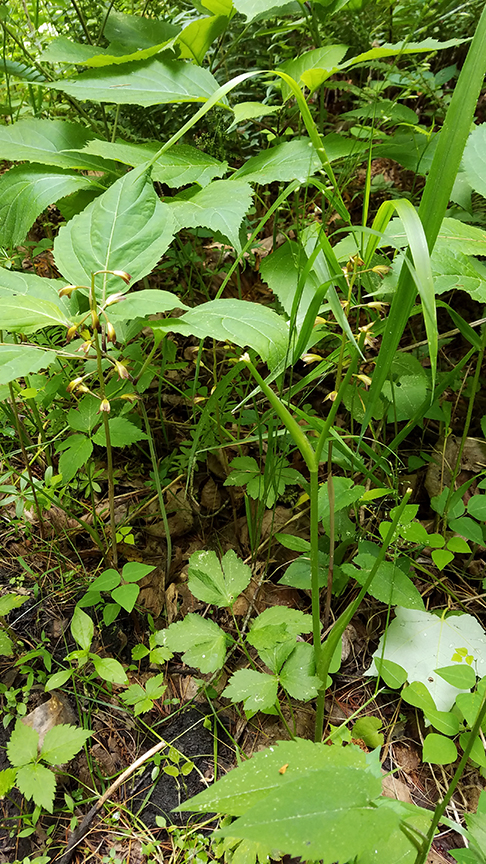 | |
| View from the Dan Ingalls Overlook. |
The day after my workshop at the Red House had taken place I decided to explore the Dan Ingalls Overlook Trail. A few days earlier I had stopped off at the overlook to take in the amazing view on my way back from Warm Springs, and thought the trail would definitely be worth exploring. It was probably not going to be an easy 1.2 miles to the top, because the first portion looked to be a steep climb uphill.
This tract of land on the highest portion of Warm Springs Mountain was acquired by the Nature Conservancy some 40 years earlier, according to the self-guided tour signage. It had previously been grazed for a long time, with only a few large shade trees growing on it. It was thus surprising to see how quickly the forest and native vegetation had regenerated.
The signage identified a number of native trees and a few that weren't: American Linden (Tilia americana), striped maple (Acer pennsylvanicum), sugar maple (Acer saccharum), Norway maple (Acer platanoides, a non-native species), Pignut (Carya glabra), red hicory (Cayra ovalis), and bitternut hickory (Carya cordifolia), American hornbeam (Carpinus carolinianus) and hop hornbeam (Ostrya virginiana), black cherry (Prunus serotina)--in all a great diversity of species.
 |
| Solomon' seal (Polygonatum biflorum) |
Once I got past the steep meadow, the trail leveled off into the forest, where I came across several Solomon's seal plants of impressive stature and bloom. Nearby were some early Meadow Rue plants exhibiting flowers of both sexes, again huge in size. I deduce that part of the fertility of the soil here might be due to all those years of being enriched by cow manure.
 |
| Meadow rue (Thalictrum dioicum) with male flowers |
 |
| Virginia waterleaf (Hydrophyllum virginianum) |
The Virginia waterleaf had just about finished blooming, but other summer flowers such as spiked lobelias, some heucheras and a native beardtongue I'm guessing is Appalachian beardtongue (Penstemon canescens) appeared by the sides of the trail.
 |
| Spiked Lobelia (Lobelia spicata) |
 |
| Heuchera americana in bud. |
 |
| Appalachian beardtongue (Penstemon canescens) |
I kept walking on the path through the forest, grateful for the shade--it was quite warm when I started and had become hotter as the afternoon progressed. Eventually I reached the top loop, a rocky promontory rising above the rest of the terrain. I wish the trail guide had warned about this stretch--it was tricky footing to get around the rocks, and I could have used a climbing pole or two here.
 |
| Whorled loosestrife (Lysimachia quadrifolia) |
There were huckleberry plants growing among the rocks, and whorled loosestrife was blooming profusely. I found an interesting plant with blueberry-like flowers, which after looking it up I believe is spreading dogbane (Apocynum androsaemifolium). This plant is more typical of New England and northerly climates; I presume it's one of the remnants of boreal vegetation that migrated south during the last Ice Age and persists in the higher elevations of the Appalachian mountains today.
 |
| Spreading dogbane (Apocynum androsaemifolium) |
I reached a staircase leading to a raised stone platform that offered another view similar to the one from the roadside overlook, though a bit cut off by the trees. The platform is probably some five hundred feet above the road overlook.
 |
| View from the top platform |
The trail over the rocks reminded me somewhat of the Billy Goat Trail at Great Falls Park in Maryland, but shaded and much more overgrown. Blackberry vines grasped at my clothing, and at one point the displaced vines swung back hard enough for the thorns to scratch me until my entire arm was covered in blood. I managed to find a paper towel to wipe my arm, fearing attracting blood-sucking insects, before going on.
 |
| Great Spangled Fritillary butterflies. |
Once I completed the rocky loop backtracking on the trail now downhill, I reached the starting point in much less time than it had taken to get to the top. Back in the grassy meadow I found two lovely Great Spangled Fritillaries dancing among the flowers, and got a nice shot of them. It was beastly hot, but I drove to Warm Springs, and sweaty as I was, stopped at the art gallery there to see if it was open, which it was. I made my purchase and drove back to the Red House, getting there just in time--a severe storm broke as I went into the house.
The wind and thunder were ferocious and the rain came down in buckets (neighboring Highland County recorded a rate of two inches per hour). The power went out a few minutes into the storm, and the outage lasted about three hours. I ate a cold dinner by candlelight that evening, since I couldn't reheat my leftovers, and put a pan in the kitchen to catch the drips from the roof.













































